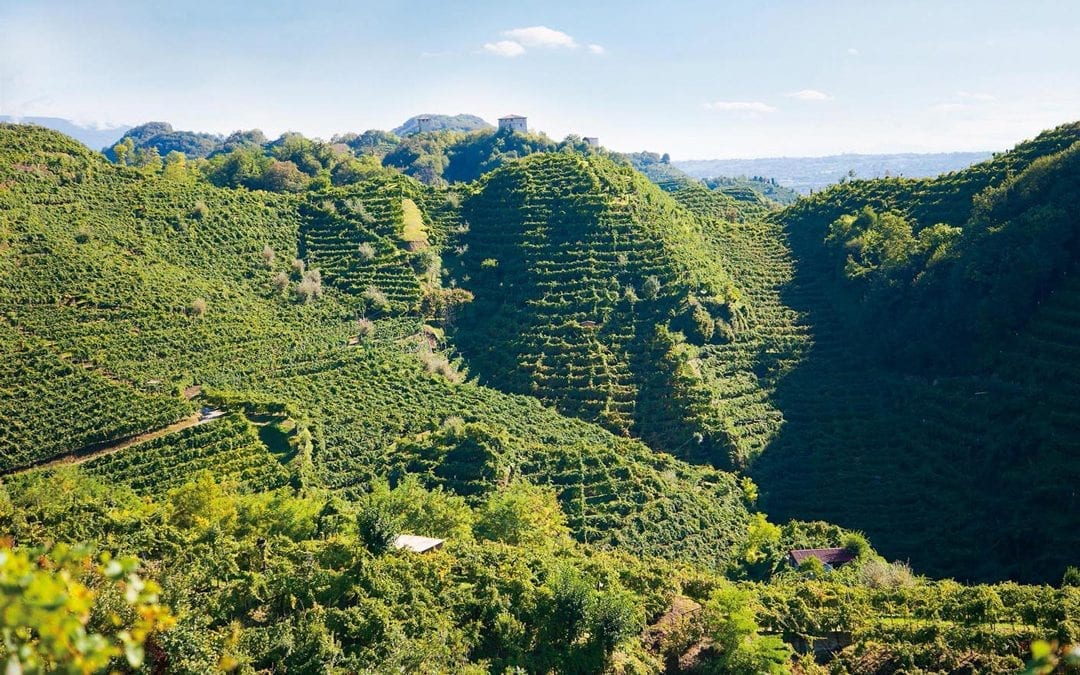At the end of the public release of my Sparkling Wine Guide 500 bubbles in 500I want to say a few words about one of Italy's most mistreated bubbles: Prosecco and, in particular, one of its small crus, the Prosecco di Valdobbiadene Superiore di Cartizze DOCG. I will tell you in advance that I have given very little space to this denomination in my Guide, but not because there are no bubbles of absolute quality in between, but because the Veneto, as well as Lombardy and Trentino, have always been the most talked about regions when it comes to bubbles... and I am very keen for you to discover some sparkling wines outside the 'usual routes'. Prosecco Valdobbiadene Superiore Cartizze, however, is to all intents and purposes a bubble that can give great satisfaction, especially if you are having an aperitif with your friends, for its ability to accompany your conversations with taste and freshness without interrupting them!
Prosecco Valdobbiadene Superiore Cartizze: Production Zones
Prosecco Valdobbiadene Superiore Cartizze is produced in a small Cru of only 107 hectares of vineyards divided among 117 producers, in the municipality of Valdobbiadene and, more precisely, in the localities of San Pietro di Barbozza, Santo Stefano and Saccol.
Prosecco Valdobbiadene Superiore Cartizze: history and origins of the name
The name 'Cartizze' seems to be a derivation of 'gardiz or gardizze', as the racks used to dry the grapes are called. In fact, in the cru of Cartizze, thanks also to the characteristic pedoclimatic environment, the grapes are harvested late, only after showing the first signs of natural drying. This choice certainly means that, thanks to the lower water content in the berries, the aromas and flavours are concentrated, making the wine produced of superior organoleptic quality.
In the old days, when the grapes were ready for harvest, they were wrapped bunch by bunch in gardizze, or rather Cartize. The result of this meticulous process was a sweet wine, almost a passito. While this type of wine was very popular at the beginning of the last century, around the 1950s the popularity of sweet wines came to a colossal halt and the need arose to seek a new way to enhance these areas so generous with fragrant grapes.
The idea of transforming the Cru di Cartizze and bringing it closer to the more traditional Prosecco is actually an excellent commercial gimmick that also has interesting taste-olfactory implications: in fact, carbon dioxide has the merit of increasing not only the hard sensations that perfectly balance these naturally soft and sweet grapes, but also greatly enhances the perception of aromas.
The grapes, ready for harvest, were wrapped bunch by bunch in 'cartizze' to increase the sugar content of the grapes. The wine thus obtained, Cartizze in fact, was thus a dessert wine, closer to Picolit or Passiti. This type was very popular at the beginning of the century. With the last post-war period, the popularity of sweet wines plummeted, up to the present day, where very little sugar and a 'light' colour is required of sparkling wine. Thus the processing of the cru of S. Stefano was aligned with that of the common prosecco, maintaining only the use of the late harvest. Today's Cartizze thus shares almost all qualities with Prosecchi, emphasising, however, its decidedly richer and more intense bouquet.
You can now subscribe to my newsletter or scroll down the page to continue reading the article! 😉
Prosecco Valdobbiadene Superiore Cartizze: organoleptic characteristics
Although it is to all intents and purposes a prosecco, it has a more intense colour, a broader bouquet of aromas and is stronger and more structured on the palate. This is due both to the particular terroir, but also to the method of vinification! While Prosecco is mostly vinified with the Charmat Method, Cartizze is made with the Metodo Charmat Lungo or even the Metodo Classico! I must also tell you that Cartizze, however, is considerably more expensive than classic Prosecco di Conegliano or Valdobbiadene. However, if you choose a good product and you like wines of this type, I am sure you will be happy to uncork a bottle with friends! Then of course, Cartizze sounds a bit like a legend to a taster, but sometimes even legends have great charm... don't you think?
Cheers 🙂
Chiara
Speaking of Prosecco, how about reading this article on Le Vigne di Alice and Bellenda's Prosecco Integrali?


